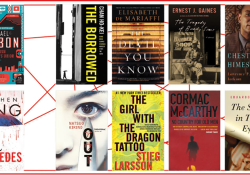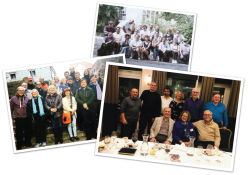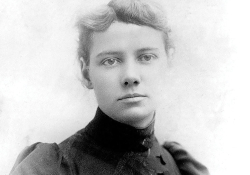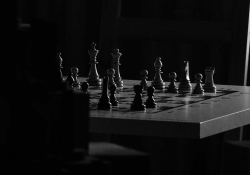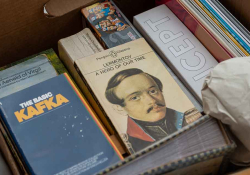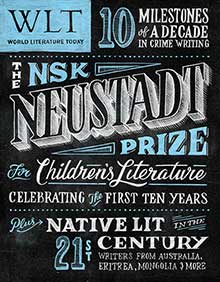Ten for Your Consideration: Milestones of a Decade in Crime Writing
It is hard for me to believe that this column has appeared in almost every issue of WLT for a decade, and I am gratified that it has been so well received. For that I thank WLT’s readers, crime writers around the globe, and the brilliant editorial job of the staff. A ten-year anniversary is an appropriate time to hoist a glass—don’t you think?—and to offer for your consideration ten international crime books that might be considered milestones of the decade.
Notice I don’t call this a “ten best” list. As W. H. Auden put it: literature is not a horse race. Besides the difficulty of handicapping books in many languages, the standards are fluid. Do we measure quality by influence? By commercial success? By innovation or by mastery of traditional forms? By emotional or philosophical power? A combination based on some algorithm? Do we favor the flawless gem over the great blue carbuncle? With the advice of many of my writing colleagues from around the world, I offer the following, knowing full well there are many other worthy possibilities that deserve equal attention.
The great carbuncle of the last decade was, of course, The Girl with the Dragon Tattoo, by Stieg Larsson. If somehow you’ve missed it, you are way outside the loop. Published shortly after Larsson’s fatal heart attack in 2004, the book sold thirty million copies by 2010 and had been translated into forty-four languages. At present, it and the other books of the trilogy have sold at least seventy-five million copies. Larsson’s early death—his last words were said to be “I’m only fifty”—led to a number of controversies, including the extent of his publisher’s revisions. Several Scandinavian writers confided to me that they thought the English translation was far superior to the original. To me, the book is a stew, combining various popular meats and vegetables, a recipe for a best-seller with something for everyone. At its center is a traditional “locked room” mystery (in this case, a “locked” island) with a limited number of suspects. We have a detecting pair, the crusading reporter and an Aspergerian antihero, and blatant themes, like corporate fascism and the abuse of women. It manages to seem like something new, without having anything original in it. The Hollywood dream. Perfect entertainment. And, of course, swept along with the Nordic crime wave.
Scandinavian noir in general was a huge influence in the past ten years. Countries with comparatively little crime produced grim novels by the likes of Henning Mankell, Kristina Ohlsson (both of Sweden), Arnaldur Indriðason (Iceland), Christian Jungersen (Denmark), Karin Fossum, and Anne Holt (both of Norway). The quality of these writers is high, but Jo Nesbø (Norway) seems to me to have a broader palette, approaching his stories from unusual angles. Choosing a single book by a writer who is consistently excellent is difficult. I will cheat a bit here and recommend The Redbreast, which was published in Norway in 2000 but not in English until 2006. It tells of a contemporary conspiracy with roots in Norwegian Nazi sympathizers. Much of the book takes place on the Eastern Front in World War II and draws on Nesbø’s father’s experiences as a pro-Axis volunteer.
Christopher MacLehose, the publisher who brought Larsson to English translation, has said that the “next big thing” in crime writing is a resurgence of the French, and the book most frequently mentioned is Pierre Lemaitre’s Alex. Lemaitre is a winner of the Prix Goncourt, France’s most prestigious literary award, for his World War I epic Au revoir là-haut (2013), but Alex is his first novel translated into English. A shocking novel in which the hunted becomes the hunter, Alex features a short, odd police detective named Camille Verhoeven in a story of sexual revenge and sadism, with echoes of Jeffrey Deaver.
Also with a huge international following is Frédérique Audoin-Rouzeau, an archaeologist who uses the pen name Fred Vargas. It is impossible not to mention her. She is the only person to have won the Crime Writers Association International Dagger for three successive novels, but, as with Nesbø, it is hard to single out any one of them as remarkably better than the rest.
Instead I offer the more unsettling Dominique Manotti, historian and activist. She says that she became a novelist out of disappointment with François Mitterand’s inability to remake French society, and the crime novel seemed the best way to express the experiences of her generation, the perfect vehicle for social and political criticism. Sombre sentier (1995; Eng. Rough Trade, 1995) established her reputation, and many think L’évasion (2013;Eng. Escape, 2014), the story of an Italian convict who escapes to Paris, is her best.
In a different vein, many German-language readers praise Heinrich Steinfest as standing out in the past ten years. He takes a satirical approach to Europe’s current preoccupations with immigration and culture. An artist who was active in experimental theater, Steinfest was born in Australia but spent most of his life in Vienna and now lives in Stuttgart. His most-noted novels feature a one-armed detective, Cheng, born in Vienna to Chinese parents who immigrated because of their love for the waltz. Critics seem to find Steinfest either hilarious or baffling as Cheng pursues odd cases. Ein dickes Fell (2006; A thick skin) is the novel most recommended by my correspondents; however, like an Austrian Carl Hiaasen, the quality of his linguistic humor may not translate well, and his influence may not be felt as significantly outside the German-language world.
Among Spanish-language authors, Juan Gabriel Vásquez seems to be riding highest at the moment, even considering the formidable competition of Leonardo Padura (Cuba), Élmer Mendoza (Mexico), Pedro Herrasti (Spain), Jorge Franco (Colombia), Arturo Pérez-Reverte (Spain), and Carlos Ruiz Zafón (Spain). A Colombian writer will always find his work compared to the imaginative visions of Gabriel García Márquez, but Vásquez has called magical realism the least interesting part of One Hundred Years of Solitude and insists on representing the “disproportionate reality” of the violence and cruelty of Colombia’s history. Even in magical realism’s heyday, many Latin American authors complained about being coerced toward the fanciful. Vásquez’s realism suits the noir impulse that is the Great Flood of current crime writing. His first novel translated into English, Los informantes (2004; Eng. The Informers, 2008), focused on the betrayals of refugees from Hitler during World War II. El ruido de las cosas al caer(2008;Eng. The Sound of Things Falling, 2011), however, is more of a crime novel, using the solving of a murder as a means to grasp the psychological identity of the amateur detective and, through that, the identity of Colombia itself. With his direct, consciously unflamboyant style, Vázquez is a remarkable talent whose writing may reshape the whole landscape of Spanish-language crime writing.
Japan has long had a fascination with and a tradition of crime writing, and the range of types equals those of English-language publishing. A traditional writer of puzzle mysteries, Soji Shimada holds great stature as the “godfather” of Shinhonkaku, “logic mysteries.” At the other end of the spectrum, Kenzo Kitakata’s hard-boiled mysteries have won numerous prizes over more than twenty years. More familiar in Western translation are novels with strong social elements, provoked by the recent economic problems and by the examination of the roles of women. Natsuo Kirino’s novels (Out and Grotesque) are probably the best known of these. Miyuki Miyabe’s suspense novels deal with consumer debt and identity theft (All She Was Worth) or a possible child murder (The Sleeping Dragon). Yet because of the lag in translation time, Western readers generally remain a decade or more behind the Japanese scene. For this reason, I’ll recommend The Eighth Day (2010), a very popular novel by Mitsuyo Kakuta about the abduction of an infant and the child’s subsequent attempts as an adult to escape the consequences of it. Not yet fifty, Kakuta has won many literary prizes in a career that began when she was a university student.
Smaller nations have a hard time getting noticed in the global market for crime writing. Sometimes the culture is not accommodating to some of the premises of the conventional crime story, and foreign readers don’t know what to make of them. Sometimes there is less of a crime writing tradition in the literature. The novels of Petros Markaris are finally getting some notice by English readers. Cinephiles are familiar with his screenplays done with director Theo Angelopoulos, and he is known in Greece for his translations of Goethe and Bertolt Brecht. Born in Istanbul in 1937, Markaris has a detective series that is popular in several European countries, and despite his age, he is a great influence on younger writers. The series uses a grumpy detective, Costas Haritos, to examine the financial crisis and other social issues contemporary Greece is grappling with. Like many of the writers identified with Mediterranean noir, the globalization of crime is one of his main themes and is best represented in Che Committed Suicide (2009). To get a flavor of an authentic contemporary Greece, however, any of the novels will do: The Late-Night News, Deadline in Athens, Zone Defence. Several others translations are available in languages other than English.
George Arion, whose Atac în biblioteca (1983; Eng. Attack in the Library, 2011) is often considered a watershed between communist-era potboilers with their CIA villains and the modern thriller, achieved a significant breakthrough when Attack was translated into English and published by Profusion Books, along with novels by Bogdan Hrib and Oana Stoica-Mujea. Perhaps more significant, however, is that with over a dozen thrillers to his credit (plays, poems, songs, and extensive nonfiction as well), he also achieved his first publication in France with the international thriller Cible Royale (2014; Royal target), about agents trying to prevent an assassination attempt upon Romania’s exiled King Michael. With this publication, Romania has joined in the game and may now offer its own unique elements to the crime novel.
Finally, let me recommend an author in another language that is not as commonly translated into English, Charles den Tex of the Netherlands. Setting his thrillers in the contemporary corporate world, Den Tex draws on his work experiences to create the context for his novels. While all novels are in some way fantasies, I think we appreciate when a crime writer takes us into a reality most authors cannot re-create—or even understand. Many important parts of society are only cursorily represented in our entertainment reading, mostly because most authors don’t know anything about data mining, corporate structure, and other technical matters. Half of Den Tex’s novels have been nominated for Dutch crime writing prizes, and his 2005 novel De macht van meneer Miller (The power of Mr. Miller) is to be released next year in England as Mr. Miller.
That’s ten novels, but for lagniappe let me include a reference book that to my mind is one of the most significant books on crime fiction in the past decade. The Dictionnaire des Littératures Policières (2003, 2007) is a huge reference—published in 2 volumes, with around 2 million words, 3,000 articles, and 3,000 photos—that covers 2,200 authors and 400 characters. It weighs nearly 9 pounds and recounts the history of crime fiction in 15 countries, lists all the awards given around the world, and explains the meaning of such words as whodunit, thriller, black novel, hardboiled, etc. It examines the links between movies and literature, graphic novels and literature. It covers topics such as alcohol in mysteries, homosexuality, the role monkeys play, locked rooms, and crime-fiction events such as the Semana Negra de Gijon and the AIEP. Claude Mesplède worked with eighty people for seven years to compile it. If you read French, it is an invaluable resource. If you do not read French, c’est dommage! Let’s hope that someone translates it soon.
University of Oklahoma

